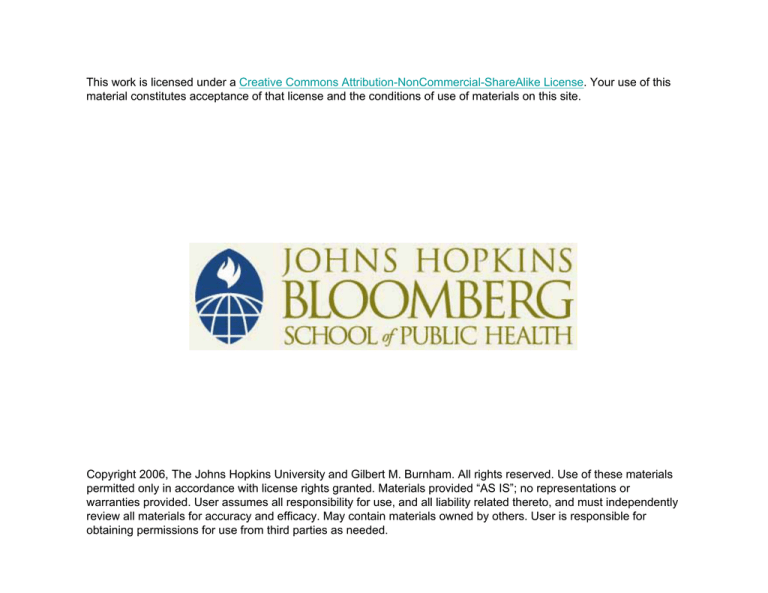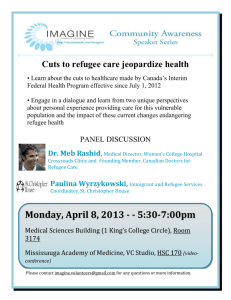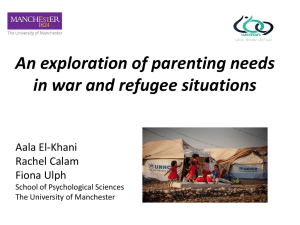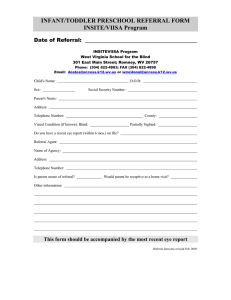
This work is licensed under a Creative Commons Attribution-NonCommercial-ShareAlike License. Your use of this
material constitutes acceptance of that license and the conditions of use of materials on this site.
Copyright 2006, The Johns Hopkins University and Gilbert M. Burnham. All rights reserved. Use of these materials
permitted only in accordance with license rights granted. Materials provided “AS IS”; no representations or
warranties provided. User assumes all responsibility for use, and all liability related thereto, and must independently
review all materials for accuracy and efficacy. May contain materials owned by others. User is responsible for
obtaining permissions for use from third parties as needed.
Establishing Health Services
Gilbert Burnham, MD, MPH
Johns Hopkins University
Lecture Outline
Section A: Health Needs
Section B: Disease Focus vs. Health Focus
Section C: What Should a Health System Be
Able to Do in Emergencies?
Section D: Manner of Providing Health
Services
Section E: Making Specific Decisions
Section F: How Much of What Is Needed?
2
Section A
Health Needs
What are the Health-Related
Needs of the Displaced?
When people are displaced to an area, what
would cause them to become ill?
– Diseases they brought with them
– Diseases they acquired locally
– Diseases related to changes in their
circumstances
4
What Health Services Do
Displaced Persons Need?
Treatment of diseases and injuries
Prevention of illness via medical means
Primary
Prevention
Secondary
Prevention
Tertiary
Prevention
Immunization against measles, meningitis, etc.
Treatment of tuberculosis, leprosy, cholera, etc.
Rehabilitation of land mine injuries
Continued
5
What Health Services Do
Displaced Persons Need?
Provision of health-related services
– Water, food, shelter
Identifying the vulnerable for improved
access to those at risk of disease
A major risk factor is forced dependency
6
Section B
Disease Focus vs. Health Focus
Disease Focus vs. Health Focus
Disease focus unable to address issues
Disease is not just the absence of correct
diagnosis and treatment
Disease is the absence of a correct public
health approach looking at all factors which
address health of a community
8
Vicious Cycle of Health Care
Curative services futile if not coupled with
public health measures
Seek Treatment
Malnutrition
Diarrhea
Measles
Malaria
Pneumonia
Scabies
Intestinal Parasites
Tuberculosis
STIs
Health Services
Return to Environment
Polluted water
Inadequate food
Environs polluted
Overcrowding
Insecurity
Heat or cold
Disease Returns
9
Section C
What Should a Health System Be
Able to Do in Emergencies?
What Should a Health System Be
Able to Do in Emergencies?
Overall goals for the health system
– Reduce crude death rates to regional
levels
– Improve health status to regional norms
Continued
11
What Should a Health System Be
Able to Do in Emergencies?
1. Diagnose and treat common conditions,
especially if life-threatening
2. Active case-finding
3. Maintain adequate resources to sustain
health services
4. Prevention of diseases
5. Measure/analyze activities and results
6. Communicate with and train staff
12
Specific Health Services:
Child Health Care
Immunization (EPI) programs
Nutrition
– Promoting breastfeeding
– Growth monitoring
– Selective feedings if necessary
– Micronutrients – vitamin A, iron
Continued
13
Specific Health Services:
Child Health Care
Treat childhood illness (IMCI approach)
Standard treatment protocols
14
Specific Health Services:
General Curative Care
Common diseases
– Priorities, e.g.,
measles, ARI
– Trauma and
fractures
– Chronic diseases,
e.g. TB, asthma
In mid-level
development countries
– Diabetes,
hypertension, heart
disease, arthritis
Continued
15
Specific Health Services:
General Curative Care
Provision for outpatient and inpatient care
Prescription of drugs in an acceptable
manner
16
Specific Health Services:
Reproductive Health Care
Care during pregnancy
– Provide for safe delivery
Family planning
Care during delivery
Post delivery/post abortion care
STI treatment
HIV prevention
– Testing and counseling
17
Developing the Program
Identify Needs
- Why are we here?
18
Setting of Mission
Identification of needs
– Should be specific and quantified
wherever possible
– Needs will serve as basis for monitoring
program impact
19
Developing the Program
Identify Needs
- Why are we here?
Select Priorities
- What is important?
Continued
20
Developing the Program
Identify Needs
- Why are we here?
Select Priorities
- What is important?
Set Objectives
- What can we do?
- What do we want to do?
21
Clear Objectives are Basis of
Strong Programs
Objectives must be measurable
– Indicators for each must be easily
assessed
22
Developing the Program
Identify Needs
- Why are we here?
Select Priorities
- What is important?
Set Objectives
- What can we do?
- What do we want to do?
Consider Alternatives
Continued
23
Developing the Program
Identify Needs
- Why are we here?
Select Priorities
- What is important?
Choose Solution
- How are we going to do it?
Set Objectives
- What can we do?
- What do we want to do?
Consider Alternatives
24
Strategies Formulated to
Implement Objectives
Clear series of tasks set out
Required resources identified
Task A
Task B
Input
Task C
Input
25
Developing the Program
Monitor Progress
- How are we doing?
Identify Needs
- Why are we here?
Implement Program
Select Priorities
- What is important?
Choose Solution
- How are we going to do it?
Set Objectives
- What can we do?
- What do we want to do?
Consider Alternatives
Continued
26
Developing the Program
Monitor Progress
- How are we doing?
Evaluate Program
Identify Needs
- Why are we here?
Implement Program
Select Priorities
- What is important?
Choose Solution
- How are we going to do it?
Set Objectives
- What can we do?
- What do we want to do?
Consider Alternatives
27
Evaluation Based on Objectives
Are the objectives the correct ones?
Have they been reached?
Is there clear evidence of impact?
How will the program be altered based on
the information?
28
How to Establish Services for a
Displaced Population
Think through the development of health
system from the first
– “Since x is present, we will do y”
– “If f occurs then g will be needed”
29
Apply the Planning Cycle
Assess
Monitor
Identify Needs
Implement Program
Select Priorities
Choose Solutions
Set Objectives
Consider Alternatives
30
Carry out a
Systematic Assessment
Identify all obvious health problems
– Some for immediate attention
– Others for subsequent attention
31
Decide on Immediate Priorities
for Treatment
The 2 X 2 table:
Risk of serious
illness or death
Frequency of disease
diagnosis
High
Low
High
Low
32
Consider Consequences of Not
Addressing the Problem
Consider the consequence of . . .
– Low immunization coverage for measles
– Low immunization coverage for BCG
– Large population in known cholera area
– Widespread scabies or lice
– Large adolescent population
33
Involve Affected Community
Seek refugee community participation
– In priority selection
– In program design
This will promote program ownership
34
Consider Alternatives and Select
Appropriate Solution
Use decision matrix to select the potentially
most feasible and effective solution
SOLUTION
A
B
C
D
Feasibility
Acceptance
Cost
Sustainability
TOTAL SCORE
35
Set Objectives to Reflect
Possible Events
Set program objectives
for program monitoring
and evaluation
– Short-term
objectives
– Longer-term
objectives
Ensure objectives are
“SMART”
– Simple
– Measurable
– Attainable
– Realistic
– Time-bound
36
Determine Strategy and
Establish Monitoring System
Determine strategy and methods
Implement program
Use information system to monitor process,
outputs and outcomes, as capacity allows
INPUTS
PROCESS
OUTPUTS
OUTCOMES
37
Section D
Manner of Providing Health
Services
In What Manner Should Health
Services Be Provided?
Health care is based on Primary Health Care
principles
PHC seeks to do the following:
– Provide acceptable and affordable health
care
– Provide optimum rather than maximum
health care
39
Themes of PHC
Education about main health problems
– Including prevention and control
Promotion of food supply and proper
nutrition
Adequate supply of safe water and basic
sanitation
Maternal and child health care, including
family planning
Continued
40
Themes of PHC
Immunization against major diseases
Prevention and control of locally endemic
diseases
Appropriate treatment of common
diseases/injuries
Provision of essential drugs
41
Different Levels of Health Care
By Frequency of Needs
Requires Referral Hospital Care
Requires District Hospital Care
Requires a Health Center
Community Health Worker Can Treat
Treatable at Home
42
Resources Required to Provide
Health Care
Referral Hospital
District Hospital
Health Center
Community Health Worker
Family
43
Section E
Making Specific Decisions
Specific Decisions to Be Made
Establish new services vs. augment existing
services
Where possible, the choice is to strengthen
local services
45
Deciding Whether to Strengthen
Local Services
Hospital Level
Health Center Level
Health Post
Community Services
New facilities very costly
New facilities often needed
New facilities usually needed
Specific for displaced populations
46
Setting Staff Requirements
Staff requirements depend on the following:
– Skills and capacity
– Main tasks to be done
– Resource requirements for each
Selection of staff
– Refugee vs. National vs. Expatriate
– Seconded government staff
Continued
47
Setting Staff Requirements
Need personnel policies for the following:
– Job descriptions
– Contracts
– Disciplinary procedures
48
Establishing a Drug Program
Follow Essential Drugs Programme (1977)
Set drug procurement guidelines
Define drug selections for various levels of
health care
Promote “rational” prescribing habits
– Organizational practices
– Host country policy
49
Drug Donations
Donated drugs often a disaster in
themselves:
– Inappropriate or unknown medications
– Outdated
– Unreadable instructions
– Clutter up warehouses, take up personnel
time
50
New Emergency Health Kit
Contains drugs and medical supplies for
10,000 persons for three months
– 10 basic units for PHC workers
– One supplementary unit for higher-level
workers
Continued
51
New Emergency Health Kit
Does not cover all drug requirements
– Chronic diseases
– Psychotropic drugs
52
Section F
How Much of What is Needed?
First Referral Hospital
Capacity—1:150,000–300,000
Services provided
– Emergency surgery
– Emergency obstetrical care
– Blood banking
– Basic laboratory
Continued
54
First Referral Hospital
Key staff
– At least two medical officers
– Adequate nursing staff (20+)
55
Health Center
Capacity—1:30,000 or 10 km radius
Staffing—health care workers, nurses,
±medical officer, ±simple laboratory
May have inpatient beds and a maternity unit
– Refer to 1st level hospital
56
Health Posts or Dispensaries
Capacity—1:10,000 persons
Referral to the health center
Key staff—medical auxiliaries (primary
health care workers)
– Community Health Workers (CHWs) or
home visitors
57
CHWs Work out of Health Posts
Often refugees—1:500 or 1:1000
Supervision from health post
Duties include the following:
– Health promotion
– Seek out and refer ill persons
– Treat common illness—
e.g., diarrhea
– Refer seriously ill to hospital
58
How Health Services Are Utilized
Initially, may be a rush for treatment
– Pent-up demand
– Epidemics may be in progress
– 2–3% of population may use services/day
Continued
59
How Health Services Are Utilized
Steady state usually 1% of population
visiting OPD services daily
– 1% of outpatient attendance will need
inpatient care
– 1% of inpatients will need hospital referral
60
Factors Affecting Utilization
Utilization by geographic location
– OPD attendance drops by 50% for every
three km
Continued
61
Factors Affecting Utilization
Utilization by age
– Under-15s constitute 50% or more of
most developing country populations
– Under-5s constitute about 20%
and represent 50–60% of outpatients
62
What Can Health Workers Do?
HEALTH WORKER
CHW or home visitor (community-based)
Medical assistant or nurse (facility based)
Medical Officer (doctor)
POTENTIAL CAPACITY
30 persons per day
50 persons per day
40 outpatients a day
63
Source of Staff
Refugee and host country nationals wherever
possible
– Have better understanding of refugee
experiences
Potential for conflicts over pay are great
Establishing credentials of refugee staff may
be difficult
64
Consider “Down Time” for Staff
Remember “down time”
– Training
– Vacation time
– Sick leave and maternity leave
– Rest and relaxation for expatriate staff
– Consider staff turnover
65
Handing Over of Programs
Common after early phase to close down or
hand over health services
– To development-oriented NGOs
– Sometimes to host country MoH
Continued
66
Handing Over of Programs
Imperative to design programs for long-term
efficiency from the beginning
Monitoring of program effectiveness
– Measured against set objectives
– Goal to contribute to development of
refugees and host country system
67




